Dummy
Anterior cruciate ligament reconstruction
Information on anterior cruciate ligament surgery, rehabilitation and treatment options.
If you will soon have an anterior cruciate ligament reconstruction, it makes sense to read up on yourself beforehand. Here you will find everything about anterior cruciate ligament surgery and rehabilitation. You will also find information about the conservative course after a torn cruciate ligament.
Conservative:
Preoperative
Operative:
Rehab
Result
Risk
Cost
Recovering without surgery after a torn anterior cruciate ligament.
The first step of rehabilitation is to reduce fluid in the knee, improve strength, and optimize flexion and extension. But also: discussing treatment options and the pros and cons of a surgical and conservative course. The second step focuses on improving functional strength, coordination and stability. The intensity is built up according to load capacity and the exercise therapy focuses more and more on your sport. In addition to training the muscles around the knee, it is important to train the entire chain. Think of the trunk, hip and ankle. Fitness should also be built up in this phase.Progression should be evaluated in each phase. Especially in the last phase, when sports resumption is possible, it should be discussed whether resuming your sport is wise. It is an individual decision that you make in close consultation with your physical therapist or orthopedist. If necessary, you can adjust your sports level downward, or choose another sport. An anterior cruciate ligament reconstruction remains an option even then. In case of sport resumption, the intensity will have to be built up further and outdoor training should be part of this.
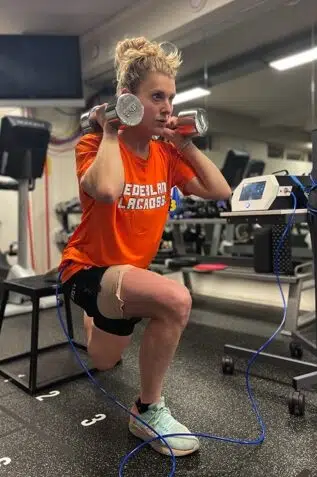
Get the most out of your knee rehabilitation!
Conservative rehabilitation will be as intensive and sport-specific as after anterior cruciate ligament reconstruction. After all, the goal is sports resumption. It means training regularly and properly under the supervision of an experienced knee specialist. Wanting to get everything out of your rehabilitation means that there is also a risk of a recurrence injury during any of the training sessions. On the other hand, without a risk, the knee is not sufficiently tested to determine a proper return to sports.
Besides physically, you also need to recover mentally. For a good return to sport, confidence in your knee is essential. Most of the time, a gradual program that ends with outdoor field training is sufficient to regain confidence. A psychologist may be an option if anxiety continues to play a significant role. Should persistent symptoms and/or instability persist, an anterior cruciate ligament reconstruction can be considered. The advantage is that you have trained well. The muscles and knee are almost recovered which is an advantage for after surgery.
Preoperative
If anterior cruciate ligament reconstruction is unavoidable, train your leg muscles before surgery and take your time to allow the knee to recover properly. The better the knee condition before surgery, the better the final result. The conditions for optimal results are good stretching, no swelling and minimal force difference (<20%) between the left and right upper leg. Be guided along the way by an experienced knee specialist. A recurrence of injury unfortunately occurs and therefore the rule is: the first shot is the best shot!

Preoperative training: better in, better out.
The orthopedist's conclusion is that anterior cruciate ligament reconstruction is necessary to regain knee stability. The doctor will refer you to a knee specialist to go over the preoperative course. This course is important to prepare you for surgery. There are a number of factors that must be in place preoperatively to positively influence the outcome of rehabilitation: no to minimal swelling, good extension and flexion and as little as possible force difference between the upper legs. If necessary, strength can be assessed with a preoperative test on the biodex.
Another positive effect of a preoperative course is that you become familiar with the exercises. Nothing is more annoying when you are still limping with pain and two crutches and have to learn all new exercises in the meantime. In addition, you usually meet other cruciate ligament clients. Fellow sufferers contact who you can ask a few things of. This way you can find out that discipline and regular training is important. Most clients are nervous before surgery, but that is only an hour of lying still. A well-functioning knee is mainly determined by your rehabilitation and you really have to do that yourself. If you can pull it off and have the perseverance, you can get the most out of your rehabilitation and recover optimally.
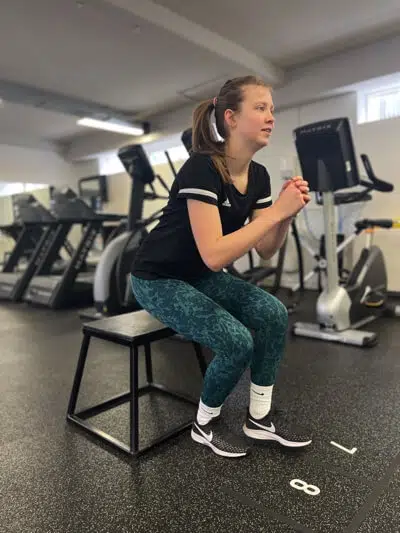
Not everyone needs surgery.
Research also shows that not everyone needs surgery. During the preoperative process, you may find that you can do well without surgery. If you do not have intensive sports needs, surgery can be postponed. You can discuss this with your physical therapist and/or doctor.
A preoperative course consists of an informational interview in addition to muscle training. During a preoperative talk, home exercises, living rules and policies surrounding physical therapy are discussed. Set goals and an end goal for yourself. It is wise to make arrangements with your employer about reintegration.
It is important to be aware of living arrangements and expectations after surgery. Consider planning regarding when to operate, studies, home situation and work. Ask your physical therapist or doctor about your specific situation.
Consider the following:
- What are the precepts?
- What exercises should you do?
- What symptoms should you look out for?
- How do you walk with crutches?
But also practical matters such as:
- How long can you not work?
- When can you ride your bike outside again?
- When will you be allowed to drive again?
- What sports can you do again soon?
Arrange your crutches in advance for after surgery. Borrowing, renting or buying from a health care storeis possible.
The anterior cruciate ligament surgery
There are several options where the tendon for the new cruciate ligament can be taken.
Which surgical technique is appropriate for you is discussed with the orthopedic surgeon.
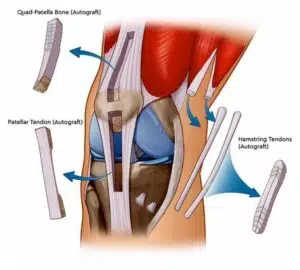
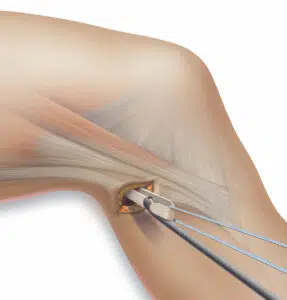
The hamstring tendon: the photo shows the extraction of the hamstring tendon from the upper bog.

Rehabilitation after anterior cruciate ligament surgery:
Rehabilitation varies from person to person and depends in part on your goals and the status of your knee preoperatively. On average, recovery takes nine to 12 months.
After surgery, you are usually allowed to go home the same day. At the hospital, you will be given a protocol for your first exercises at home. The first nights are often very painful. The stitches are removed after two weeks. In the first 10 days you can shower with water-sealing plasters or a plastic bag. For proper healing, the wound edges should not get too wet or soaked.


Start practicing
After surgery, begin stretching and bending the knee slowly. A 90-degree flexion is sufficient in the first few days. The focus is on full extension. Full extension should be achieved as soon as possible after surgery. A pillow or towel in the hollow of the knee is the biggest culprit; you can develop a stretch limitation with that. The knee is swollen and painful. The amount of swelling and pain varies from person to person. The location of the pain depends on the tendon used during surgery.
Swelling in the knee disrupts muscle control and leads to decreased stability and coordinative movement. In the process, the size of the upper leg decreases. This process cannot be stopped, but can be slowed down by beginning exercise immediately after surgery. The exercises focus on improving control of the thigh muscles and cooperation between them. Initially, the knee does not like pressure (standing and walking) but does like unloaded movement. For this reason, it is important to do a lot of bending and stretching exercises. As soon as the knee can be bent 100 degrees, cycling on an exercise bike is possible. Cycling is medicine for the knee. No pressure on the knee and still a lot of movement in a relatively short time. Cycling is allowed, after consulting your physical therapist, two to three times a day for half an hour.
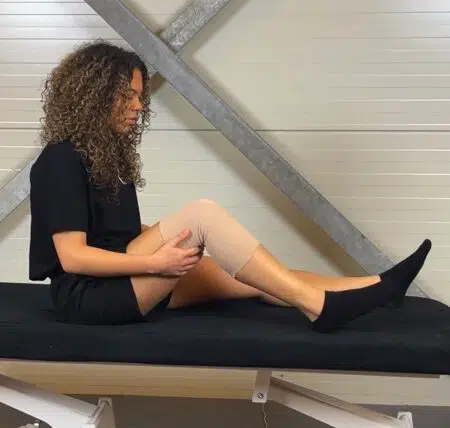
Learn to walk
Typically, you are allowed 50 percent load on your knee and walk with two crutches. The load with walking and standing may be built up based on the knee's response. Increasing swelling, stiffness and/or pain are signs that you are doing too much. Fine-tuning the load is important to build muscle strength. Increasing or persistent swelling causes muscle strength to decrease.
The use of crutches is phased out over the course of three to six weeks after surgery. Here it is important to monitor the knee's response. Phase out walking with crutches in consultation with your physical therapist.

Rehabilitation used to be time-based. All progression in rehabilitation was determined based on weeks or months after surgery. Nowadays, progression is criteria-based. In your rehabilitation, you have to be able to do certain actions or have enough strength to build up to the next step.
Sports-specific training
Training consists of strength training, functional exercises, and stability and coordination. Training does not stop at training the leg muscles, however. A strong knee begins with a trained torso and powerful abdominal and back muscles. Rehabilitation is built up to eventually move to outdoor or field training. The focus here is sports-specific rehabilitation. This is a more important component when you have the desire to return to sports. A specialized sports physical therapist can guide you through this.

After an average of six weeks, you can resume most activities of daily living. On average, after six to nine months, the knee has recovered and sports can be built up under the supervision of the physical therapist. After nine to 12 months, you can resume (build up) full sports again. However, rehabilitation does not stop there. It is important to maintain good strength and specific exercise material.
Tips:
- If you have a sedentary job, try to change positions and move the knee regularly. Do your exercises to keep the knee from stiffening up.
- While sleeping, place a pillow between the knees.
- The knee may flex after surgery, but keep in mind the wounds need to recover first. Stretching is most important!
- It may take several months until squatting and kneeling is possible again.
- Swelling can remain present for six to eight weeks and sometimes longer. Cooling with ice is pleasant and effective against pain.
Notice:
The course and development of rehabilitation are personal. Every person is different, has their own biology, sports background and experiences. Different surgical techniques or collateral damage can influence the recovery. The mental situation (fear, uncertainty, doubt etc) can also influence the course and speed up or delay it. Therefore, it is important to rehabilitate with an experienced knee specialist.
The outcome after anterior cruciate ligament surgery:
Most clients recover reasonably to well from anterior cruciate ligament reconstruction. The outcome will depend in part on the severity and extent of the injury. In addition, conditions must be right for training, and mental toughness and discipline are aspects that can affect the final result. It is also good to know that the majority of cruciate ligament clients are amateur athletes with school, jobs and/or children. These people have full-time lives in addition to their rehabilitation and cannot be engaged in their rehabilitation non-stop like a professional. Therefore, don't stare blindly at the pretty stories in the media. It's your knee and your personal recovery.
91 percent of clients expect to return to the same level of sport. In reality, only 65 percent return to the old level (amateur athletes). To the competitive level, only 55 percent return. Among professional athletes, 78-98 percent return to the old level. The chance of recurrence is about 25 percent for both the same knee and the other side. Children under the age of 18 have an even higher chance of recurrence. Therefore, take time for your recovery and slowly build up your workouts with sports.

Return to sport
91 percent of clients expect to return to the same level of sport. In reality, only 65 percent return to the old level (amateur athletes). To the competitive level, only 55 percent return. Among professional athletes, 78-98 percent return to the old level. The chance of recurrence is about 25 percent for both the same knee and the other side. Children under the age of 18 have an even higher chance of recurrence. Therefore, take time for your recovery and slowly build up your workouts with sports.
Additional information:
The outcome of your recovery (operative and conservative) will depend largely on your rehabilitation. The question of who you will have surgery by is just as important as the question of who you will rehab with. Questions that can help you select an appropriate place include:
- How many cruciate ligament rehabs a year?
- Is there a suitable space to train?
- Are there sufficient and appropriate training materials?
- Progression of rehabilitation is assessed with intermediate testing.
- Does rehabilitation conclude with performance testing?
- Is there outdoor or field training?How big is the knee team (in case of illness, vacation you must be able to pass)
- Which clinics and orthopedic surgeons are collaborating with?
A good dose of motivation, discipline, proper timing of surgery and rehabilitation are essential and together determine to a large extent the out come of your recovery.
The risks of anterior cruciate ligament surgery:
Take time for your recovery and listen carefully to your physical therapist. Adhere to the directive of rehabilitation.
Common complaints during your rehabilitation may include:
- A stiff knee when bending and/or stretching.
- Persistent pain symptoms that do not respond well to physical therapy.
- Pain around the kneecap (common but treatable).
- Overloaded knee due to excessive strain in daily life.
- Overly progressive build-up of training load.
- Slip or fall with risk of recurrence.
Knee surgery is a conscious decision and with that comes rehabilitation. It is six to 12 weeks of disciplined adherence to the precepts and homework exercises to get the best effect from the surgery. After this period, the crucial phase is over and it is important to continue getting fit.
In addition, you always have to deal with the risks of the surgery, which the orthopedic surgeon will discuss with you.
In the cases below, always contact your attending physician:
- Standing on the leg no longer possible, whereas previously it was fine.
- Fever above 38.5 degrees Celsius.
- The knee becomes abnormally thick and starts to hurt more.
- The calf is thick, red, painful and warm (possible thrombosis leg).
- If you don't trust it for other reasons
What does anterior cruciate ligament surgery cost?
In Nederland is de verzekering goed geregeld. Iedereen heeft een basisverzekering. Toch zijn er meestal veel vragen over de verzekering en fysiotherapievergoeding. Voor een uitgebreid overzicht van de kosten klik here
Conservative:
With conservative rehabilitation, physical therapy is not covered by basic insurance. If you have supplementary insurance for physiotherapy, you can use this for guidance during rehabilitation. If this is not or insufficiently the case, you pay the (remaining) physiotherapy treatments yourself.
Operative:
After surgery, you usually need intensive physical therapy. The system in the Netherlands is set up so that you need 20 treatments to fall into a chronic care program. From the 21st treatment you are chronically (unlimited medically necessary) insured for one year of physiotherapy from the date of surgery. A referral from the orthopedist is necessary for this.
For the first 20 treatments, you can insure yourself through your supplementary insurance. If you have supplementary insurance for 9 treatments, you pay for 11 treatments yourself. If you don't have supplementary insurance, you pay 20 treatments yourself. One physical therapy treatment costs about 25-35 euros.
Treatment from the supplementary package is not at the expense of your deductible. Once treatments are declared from the basic package, so from 21st treatment, you do pay excess. The operation is also paid from your deductible. The deductible runs per calendar year. If the physiotherapy treatment continues after January 1, you pay your deductible again.
After reading this information about insurance and the deductible, it is quite possible that you have questions or are unclear. The situation may vary from person to person, so always consult with your physical therapist and carefully read the terms and conditions of your insurance.
